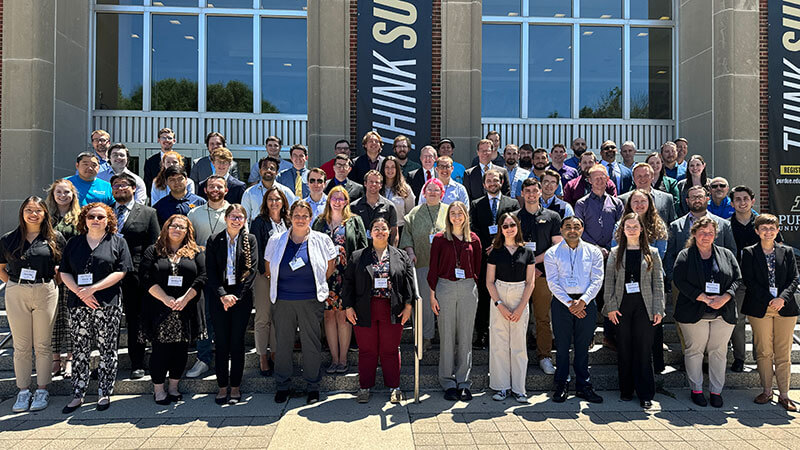First energetics talent showcase attracts students and defense professionals from across the U.S.

WEST LAFAYETTE, Ind. — The Purdue Energetics Research Center (PERC) hosted a first-of-its-kind energetic materials talent showcase that connects students and postdoctoral researchers interested in energetics careers with employers across the defense community.
The PERC – Energetics Talent Showcase (PERC-ETS), held May 29-30 on Purdue University’s campus, gave 52 students and postdocs from nine universities the opportunity to present to and network with government and industry attendees.
Energetic materials — or things that go boom — are a type of material with a high amount of chemical energy stored in their molecular structure, such as explosives, pyrotechnics and propellants. PERC focuses on comprehensive energetics materials research, addressing existing and emerging explosive-based needs for civilian and military infrastructure, commerce and aviation. It also supports the U.S. need for more stable, less sensitive and more easily processed energetic materials including propellants, pyrotechnics and explosives in ordnance.
The Department of Defense identified workforce development across the defense enterprise as a key priority in its 2022 National Defense Strategy, with the DOD aiming to attract individuals with the skills required to solve complex national security challenges. The energetic materials sector, in particular, is often affected by a lack of replacement hiring when professionals leave or retire from the field. Stephen Beaudoin, director of PERC and professor of chemical engineering, created PERC-ETS to respond to this need.
“We planned this student-focused event to foster relationships and the transition of talented, ITAR-eligible students into defense-focused careers,” Beaudoin said. “We were humbled by the excellent attendance from across academia and the defense community and overjoyed by the quantity and quality of engagement among the students and the government and industry representatives. As word gets out, we are hopeful that this will become a premier student recruiting event.”
Because few universities have programs dedicated to energetics, defense employers often struggle to recruit candidates with the proper training to handle these sensitive materials. PERC-ETS addresses this challenge by facilitating connections between recruiters and students with enough experience to dive into a research project on day one.
All participants had completed or were working on an energetic materials research project in one of the following areas: novel energetic materials, advanced diagnostics, modeling and simulation of properties/performance, and manufacturing. Phillip J. Cole, department head of energetics manufacturing at Naval Surface Warfare Center, Indian Head Division, attended PERC-ETS and attested to the growing need for a larger, more experienced energetics workforce.
“Potential new employees joining our team with meaningful exposure to an energetics environment would give us a leg up on building proficiency quickly,” Cole said. “The near-term demands on the Navy’s only public arsenal at Indian Head will require expansion of our workforce across the full spectrum of our capabilities — from basic science and technology research through decommissioning and disposal of energetics. An event like this provides a critical linkage between employers to prospective new team members that are well positioned to make an immediate contribution.”
In addition to the formal presentations and posters, PERC-ETS provided plenty of opportunities for networking. Daniel Laky, postdoctoral researcher at the University of Notre Dame and alumnus of Purdue’s chemical engineering doctoral program, secured an interview through his conversations with defense professionals.
“The event was pivotal for providing networking connections that will help my career in the future,” Laky said. “I was able to meet and speak with scientists and executives in the energetics community that I never would have met on my own accord.”
Nishan Khanal, graduate researcher and doctoral student in aerospace engineering at the University of Central Florida, appreciated the balance between the structured presentations and the more informal networking components.
“The smaller scale and more personalized aspect of the event was definitely helpful as it meant all the potential employers were able to view your presentation and past work,” Khanal said. “Having the option to talk to representatives from government and industry during the numerous break times and social events was crucial in building connections.”
PERC-ETS will become an annual event held in the spring and will biannually overlap with the invitation-only Purdue Energetic Materials Summit (PEMS). PEMS brings together scientists and engineers across government, industry and academia to discuss key challenges and potential technical solutions associated with energetic materials. The event includes technical talks, workshops, lab tours and free time allotted for conversation and community building. The last PEMS, held in June 2023, hosted over 100 energetic materials experts representing eight universities, 15 government agencies and 21 companies across the country. The next PEMS is slated for spring 2025.
About Purdue University
Purdue University is a public research institution demonstrating excellence at scale. Ranked among top 10 public universities and with two colleges in the top four in the United States, Purdue discovers and disseminates knowledge with a quality and at a scale second to none. More than 105,000 students study at Purdue across modalities and locations, including nearly 50,000 in person on the West Lafayette campus. Committed to affordability and accessibility, Purdue’s main campus has frozen tuition 13 years in a row. See how Purdue never stops in the persistent pursuit of the next giant leap — including its first comprehensive urban campus in Indianapolis, the Mitchell E. Daniels, Jr. School of Business, Purdue Computes and the One Health initiative — at https://www.purdue.edu/president/strategic-initiatives.
Writer/Media contact: Lindsey Macdonald, macdonl@purdue.edu
Source: Stephen Beaudoin, sbeaudoi@purdue.edu